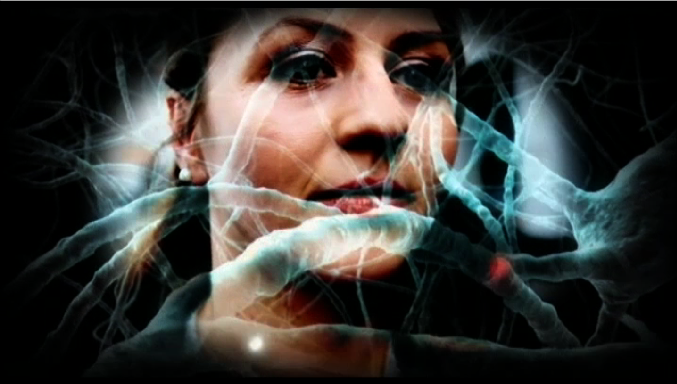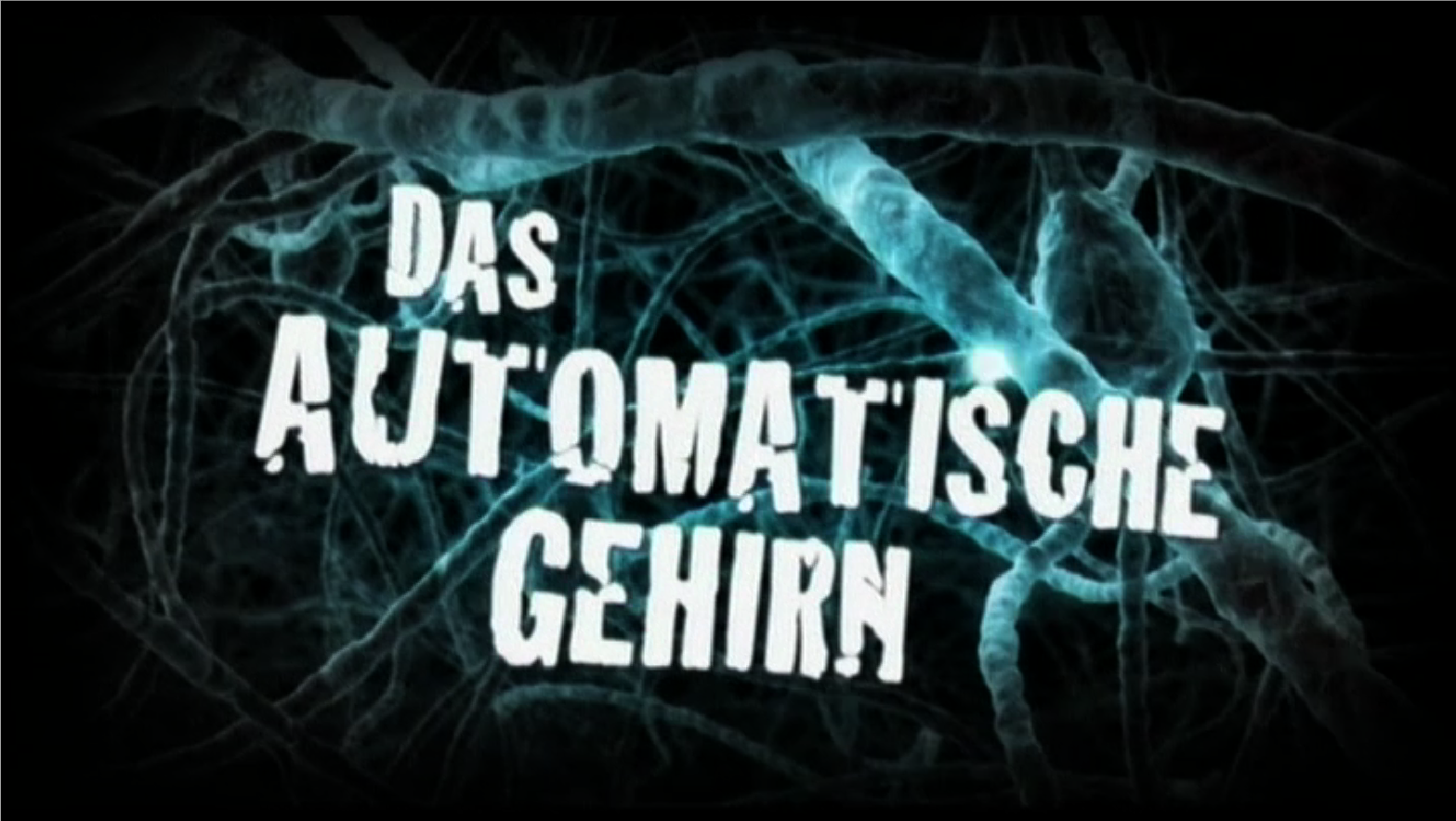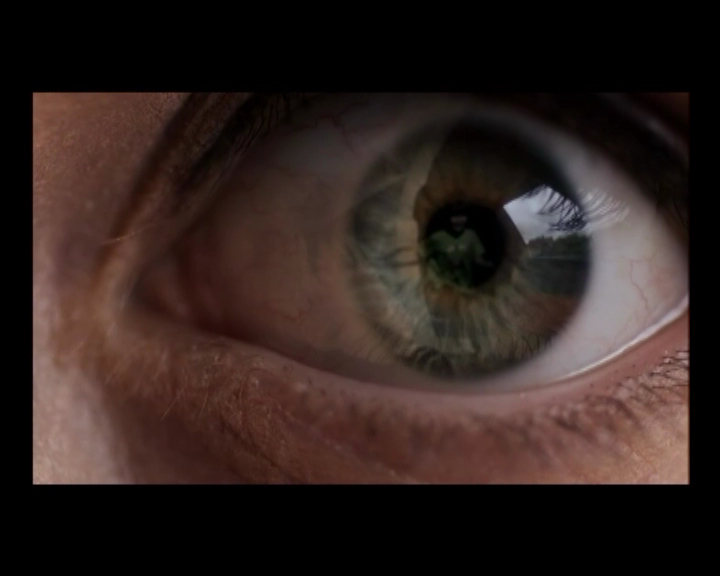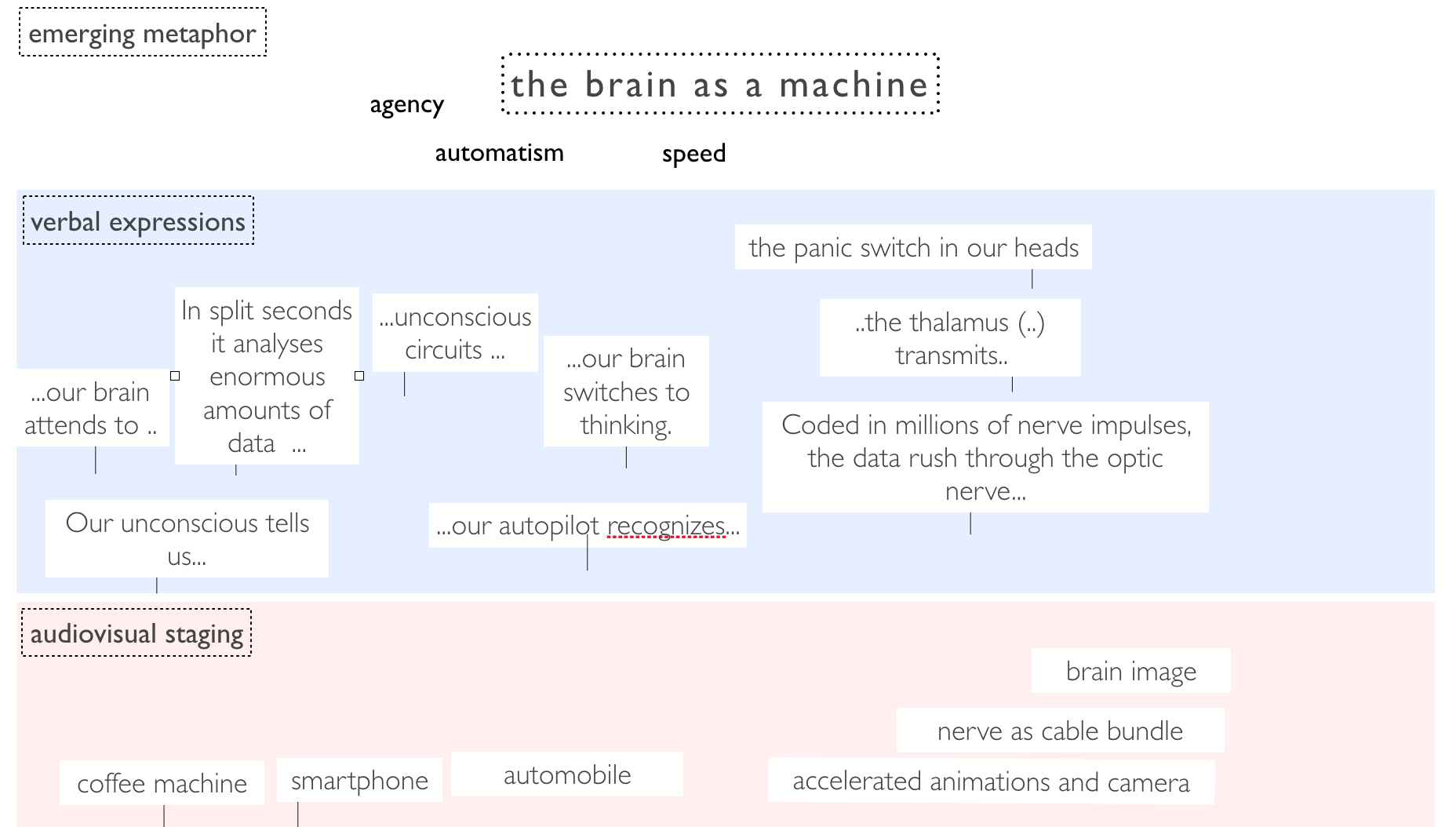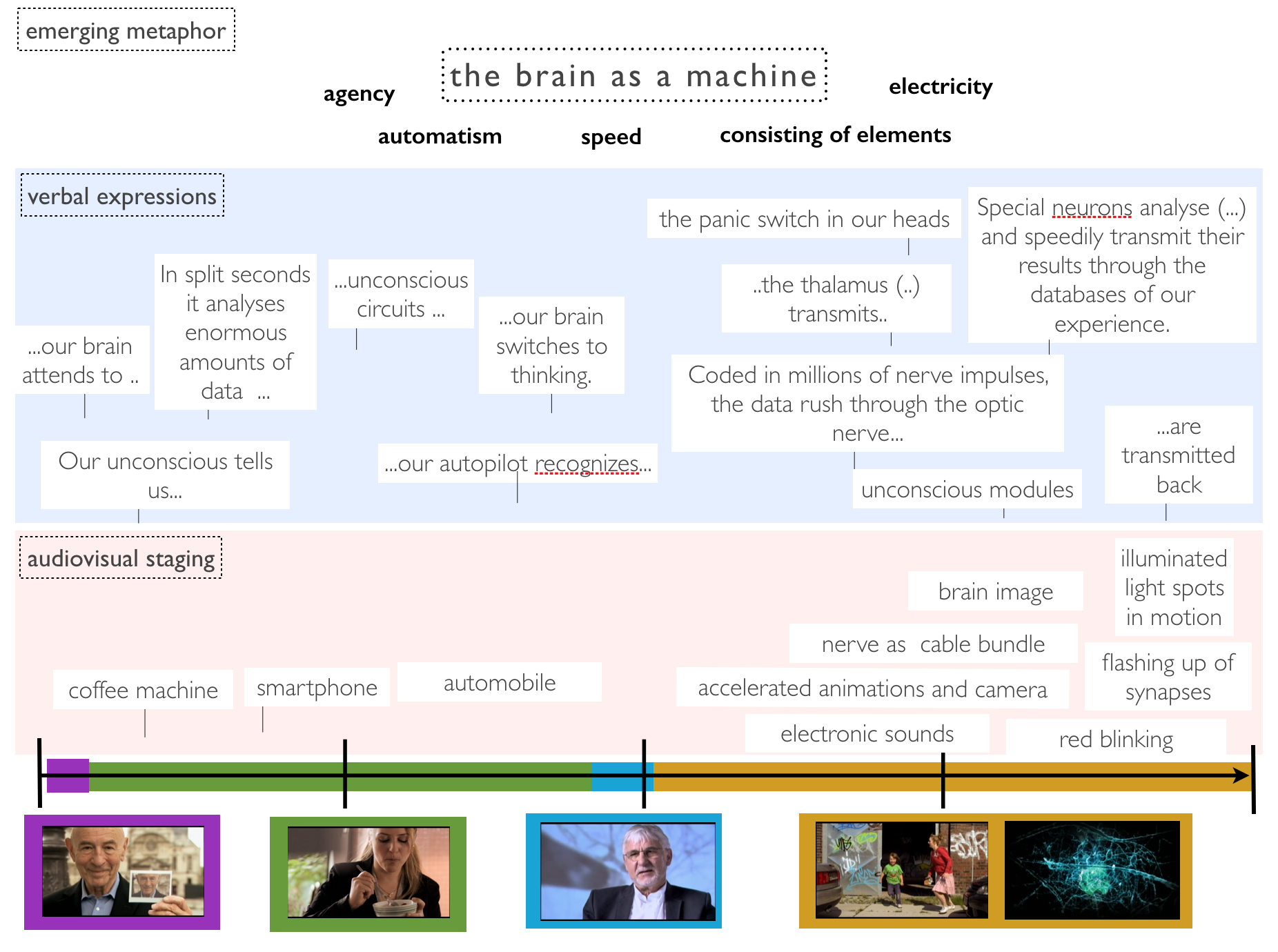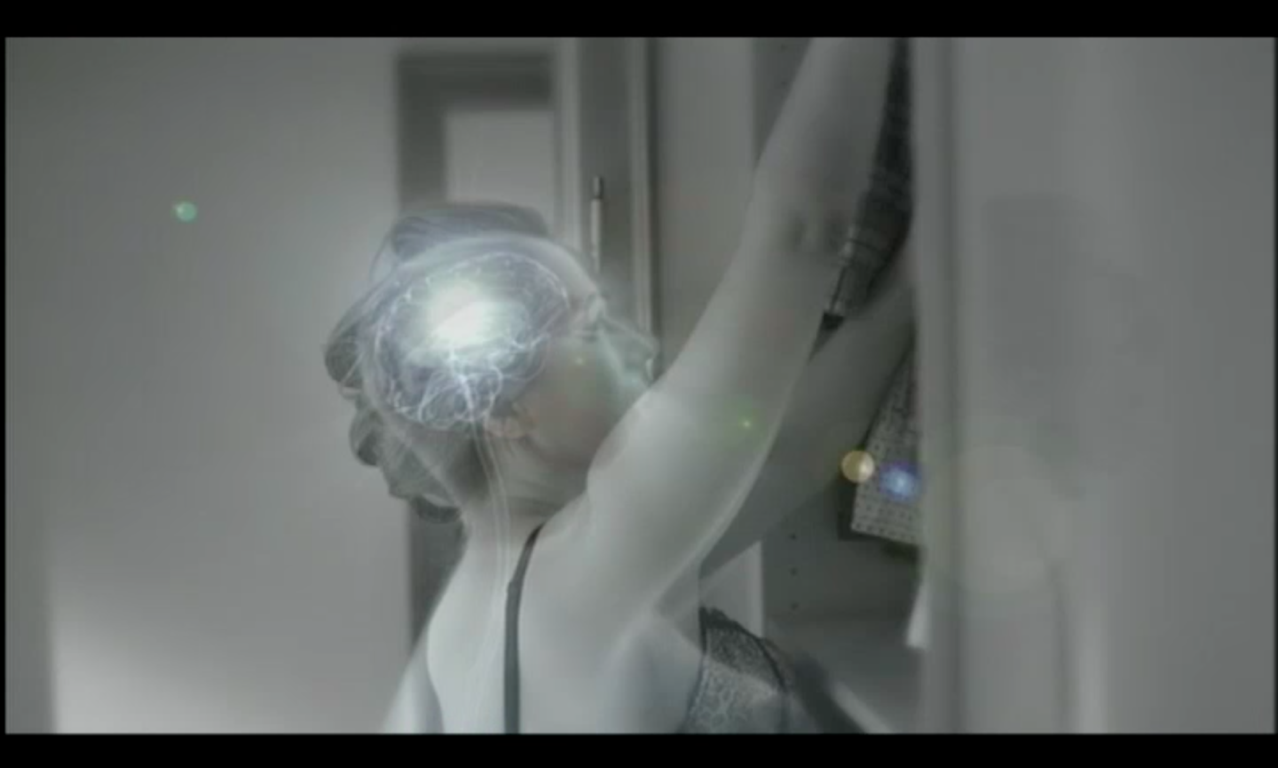Sarah Greifenstein & Regina Brückner
Introduction
Visually and acoustically, the metaphoric realm of machine is not illustrated in an obvious manner, but more subtly cued. For example, sounds of electricity are staged in conjunction with nerve cells. The colours used to represent the brain and nerves are the same colors that are used in science fiction films and more generally with regard to computers.
Clip 1: DAS AUTOMATISCHE GEHIRN (F. D’Amicis/P. Höfer/F. Röckenhaus, D 2011), Min. 0:00-0:13.
Not only sound and colours but also camera work contributes to the metaphor, even in scenes where the brain is not shown. Here we see a fast, abrupt and unnatural motion, like movement patterns of a robot.
Clip 2: DAS AUTOMATISCHE GEHIRN (F. D’Amicis/P. Höfer/F. Röckenhaus, D 2011), Min. 29:06-29:09.
Clip 3: DAS AUTOMATISCHE GEHIRN (F. D’Amicis/P. Höfer/F. Röckenhaus, D 2011), Min 17:46-21:45.
In the third and and fourth part of the scene, the source domain can be experienced through different stagings of time.
An aspect of the „brain as a machine“ - metaphor is the proclaimed high speed by which it computes data.
The aspect of the brain‘s temporality now becomes central through a scientist explaining how our conscious mind lags behind our unconscious mind.
The described temporality becomes a real temporal experience for the viewer through the use of slow and fast motion.
We see slow motion shots of a young boy, running along with a football followed by shots of cars and a shot of Marta leisurely walking along the pavement, then, in a medium long shot, the ball jumps past Marta toward us.
The motion of the image now becomes extremely slow when the boy appears behind the door. Eery, equally slow and elongated sounds make the movement audible and create an extremely dramatic atmosphere.
A brief change of speed, from slow to normal to slow motion, highlights the different temporalities.
This orchestration lets us experience that this is in fact just a split second, a standstill of time, a number of pieces of information too quick to be processed consciously.
Clip 4: DAS AUTOMATISCHE GEHIRN (F. D’Amicis/P. Höfer/F. Röckenhaus, D 2011), Min 19:42-20:09.
Now we jump to an extreme close-up of an eye, accompanied by the voice-over: “everything we see enters our pupils as a bundle of rays of light”. The moment he says “enter”, the forward movement of the camera is experienced as entering the eye, as if we ourselves were those rays of light. A change of perspective now shows us a side view of an abstract image of an eye while the commentator explains how the light hits the retina.
Accompanied by a space-ship sound, we enter the eyeball in a very dynamic movement. Leaving the still legible image of the eye into animations of the brain, the commentator says: “coded in a million nerve impulses, the data rush through the optic nerve.”
The camera moves further forward into the image of the boy, behind the retina and quickly through a tunnel of strands in a greenish-blue colour, resembling cables.
The fast movement that we experience audiovisually corresponds to the verbal mentioning of data rushing. Through this mapping of the experienced speed and the verbally mentioned speed of the data, the multimodal metaphor is gaining more shape.
This extreme rush is contrasted with the slow motion that we have experienced before, and makes the machine-like velocity perceptible. In this moment, we experience the source, the machine-like velocity, and the target, the brain, simultaneously:
Within the scene, we have now entered an open, dark space, with semi-transparent, disorderly strands of nerves that seem to spark from electricity. The commentator describes parts of the brain as elements of the machine, each having a specific function.
The thalamus as the gatekeeper who communicates with other parts such as the amygdala, the so called „panic switch in our heads”
We now see an animated transparant image of a head from outside, in which the relevant parts of the brain are illuminated.
The transmission of data is visualized by small light dots moving along paths. When the “panic switch” is mentioned, a bright red flickering light appears in one part of the brain while the camera moves closer.
The red flickering light corresponds to an alarm signal that we are familiar with in western culture. The idea, that the amygdala becomes activated and thus blinks, matches with the verbally mentioned „panic switch“.
In this part of the scene the machine‘s consisting of elements is staged and their activities and functions are visualised as light.
Clip 5: DAS AUTOMATISCHE GEHIRN (F. D’Amicis/P. Höfer/F. Röckenhaus, D 2011), Min 20:37-20:48.
Cameron, Lynne: Metaphor and reconciliation. The discourse dynamics of empathy in post-conflict conversations. New York 2011.
Fahlenbrach, Kathrin: Audiovisuelle Metaphern. Zur Körper- und Affektästhetik in Film und Fernsehen. Marburg 2010.
Goschler, Juliana: Metaphern für das Gehirn. Eine kognitiv-linguistische Untersuchung. Berlin 2008.
Johnson, Mark: The meaning of the body. Aesthetics of human understanding. Chicago 2007.
Kappelhoff, Hermann / Greifenstein, Sarah: Metaphorische Interaktion und empathische Verkörperung: Thesen zum filmischen Erfahrungsmodus. In: Malte Hagener / Ingrid Vendrell Ferran (eds.): Empathie im Film. Perspektiven der Ästhetischen Theorie, Phänomenologie und Analytischen Philosophie. Bielefeld 2017.
Kappelhoff, Hermann / Müller, Cornelia: Embodied meaning construction. Multimodal metaphor and expressive movement in speech, gesture, and in feature film. In: Metaphor and the Social World 1/2 (2011), 121-153.
Müller, Cornelia: Metaphors dead and alive, sleeping and waking. A dynamic view. Chicago 2008.
Schmitt, Christina / Greifenstein, Sarah / Kappelhoff, Hermann: Expressive movement and metaphoric meaning making in audio-visual media. In: Cornelia Müller / Alan Cienki / Ellen Fricke / Silvia H. Ladewig / David McNeill / Jana Bressem (eds.): Body _ Language _ Communication: An International Handbook on Multimodality in Human Interaction. (Handbooks of Linguistics and Communication Science 38.2). Berlin / Boston 2014, 2080-2092.
Filmography
DAS AUTOMATISCHE GEHIRN. F. D’Amicis/ P. Höfer / F. Röckenhaus, D 2011.
